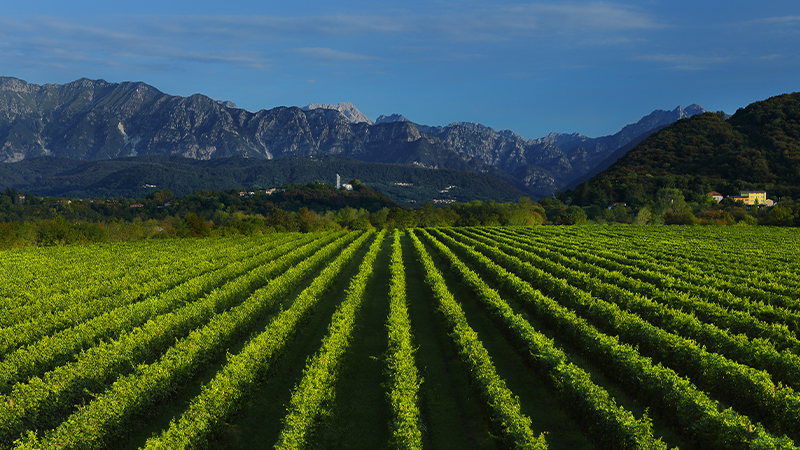
It’s the time of year when the days run long, the parties move outdoors, and life feels a little lighter. It’s also the season when true oenophiles often forgo heavier blends for varietals that are crisp and refreshing, as sparkling options often provide a perfect celebratory choice for rooftop dinner parties and impromptu backyard get-togethers. One of the most popular summer selections is an elegant, chilled bottle of Prosecco DOC, a legendary Italian sparkling wine that enhances charming conversation as effortlessly as it complements seasonal hors d’oeuvres. The world’s most popular sparkling wine is effervescent without being overpowering, animated by its storied history as the celebratory drink of emperors and culinary masters, from ancient Rome to modern day. Now, fans can also experiment with a new rosé-style bubbly, and what better time to explore a prized bottle than during the fourth annual National Prosecco Week? This year, from July 19- 25, every wine lover’s tastes will turn to all things effervescent.
Named for the former Italian village of Prosecco, now ensconced as part of modern-day Trieste, Prosecco wine enjoys a protected geographic designation label of DOC, or Denominazione di Origine Controllata, which guarantees a superior level of quality and authentication of origin.
Prosecco is produced in only nine provinces of two Italian regions, Veneto and Friuli-Venezia Giulia — Belluno, Padua, Treviso, Venice, and Vicenza in the Veneto region, and Gorizia, Pordenone, Trieste, and Udine in the Friuli region –– nestled between the waves of the Adriatic Sea and the soaring Dolomite mountains. These mighty peaks provide the rolling, chilled breezes that contribute to a unique microclimate perfectly suited to produce Prosecco’s distinct fresh, fruity flavors. The wine is made primarily from the bold Glera grape, native to northeast Italy for thousands of years, its golden spheres producing delicate notes of jasmine, citrus blossoms, and green fruit. The Glera is frequently enhanced by the inclusion of other indigenous varieties. Since 2020, the DOC has also added a rosé variety of Prosecco designated Spumante Rosé, which contains the Glera grape (85 to 95 percent) blended with 10 to 15 percent Pinot Noir, for a blush wine with a bite. The Prosecco DOC Rosé undergoes a longer secondary fermentation in the autoclaves (60 days as opposed to Prosecco DOC’s 30), has a carnation pink color, and a fine and refreshing perlage.

Prosecco wines are made using the famed Charmat-Martinotti Method, a process developed in 1895 by Italy’s Federico Martinotti and later modified by the Frenchman Eugène Charmat. Rather than producing the wine’s bubbles with a second fermentation in-bottle, the Charmat-Martinotti Method involves re-fermenting the wine in stainless steel tanks where carbonation naturally occurs after yeasts consume excess sugar and produce CO2 and alcohol. Then, as the yeast is filtered out and the sparkling wine is bottled, it is able to retain its delicate texture. Though more involved, these traditional methods yield particularly enticing fruit and floral notes, including pear and melon as well as acacia blossoms and hazelnuts.
When it comes to Prosecco, you can choose your level of fizz. Prosecco DOC comes in three levels of natural carbonation, the most famous of which is Spumante (sparkling), which features the highest level of carbonation, making it an ideal pairing for apple pies, fruit salads, Brie, and decadent, chocolate-based desserts. Frizzante (semi-sparkling) contains lighter and less persistent bubbles and provides a wonderful complement to cheese plates, shellfish and seafood, buttercream sauces, egg dishes, and foie gras. Then there’s Tranquillo (still), which offers the lightest sensation on the tongue and remains ideal for main courses of poultry and fish, or as an aperitif wine alongside sharp cheeses, Veneto salami, and prosciutto. Prosecco DOC Rosé can only be made Spumante and features a floral aroma with notes of apple, citrus, strawberry, and raspberry. Sophisticated yet flirtatious, it makes an ideal pairing with red meat entrees, seafood and oysters, and truffle appetizers, offering an alternative to typical rosés with less sugar, but sacrificing none of the fun.

Both Prosecco Frizzante and Spumante acquire their bubbles through a secondary fermentation production method, with varietals bottled under high pressure after fermentation in bulk tanks known as autoclaves. The result is brilliant bubbles of a straw yellow, with persistent perlage and moderate alcoholic content. Prosecco is also available in varying degrees of sharpness. The driest Prosecco is Brut Nature, containing 0 to 3 grams per liter of residual sugar, followed by Extra Brut (0 to 6 grams per linter), Brut (6 to 12 grams per liter), Extra Dry (12 to 17 grams per liter), Dry (17 to 32 grams per liter) and finally, the sweetest, Demi-Sec, which contains 32 to 50 grams of residual sugar per liter. Prosecco DOC Rosé sweetness ranges from Brut Nature to Extra Dry. To ensure a superior tasting (and buying!) experience, look for bottles with the Prosecco DOC’s official government seal, which guarantees origin and quality.
For bubbly-wine lovers there are certainly enough varieties of Prosecco to sample and keep you in high spirits all summer long. But no matter what bottle you choose, it’s always the right time to celebrate with a glass of bubbles, making Prosecco –– and Prosecco DOC Rosé –– the perfect drink for National Prosecco week this summer season and beyond.
This article is sponsored by Prosecco DOC.
